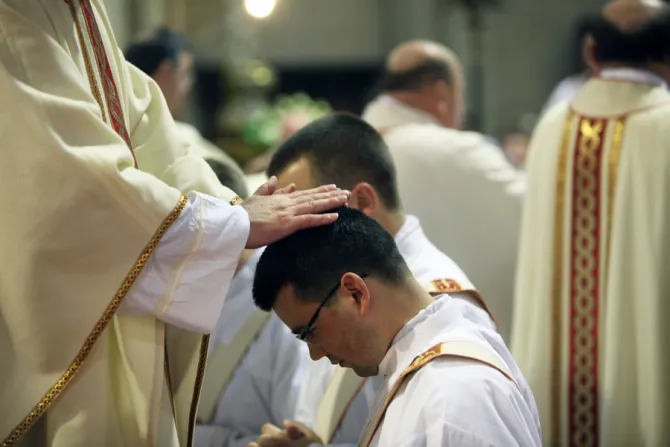CNA Staff, Apr 24, 2020 / 09:15 am
A survey of the 2020 priestly ordination class was published by the U.S. Catholic bishops' conference (USCCB) on Thursday, a slightly smaller class than in 2019.
Sponsored by the bishops' Committee on Clergy, Consecrated Life and Vocations, the survey is conducted annually of U.S. seminarians who are about to be ordained to the priesthood. The USCCB collaborates with the Center for Applied Research in the Apostolate (CARA) to produce the survey.
Ordination class sizes have varied over time, according to previous CARA reports. In 2006, there were 359 potential ordinands identified by the survey (though not all responded), a number that rose to 475 in 2007 before dipping to 401 for the class of 2008-many of whom would have entered seminary in 2002, the year that clergy sex abuse scandals in the U.S. were widely reported.
In subsequent years that number rebounded, with an average class size of 474 from 2009-14.
The ordination class size peaked in 2015 at 595, dipping slightly to 548 in 2016 before jumping again to 590 in 2017.
However, the number of potential ordinands has dipped in the past three years; from 2018-2020, CARA said it sent surveys to 430, 481, and 448 priestly ordinands, respectively.
For its reports, CARA calculates the ordination class sizes by contacting all theologates, houses of formation, dioceses, archdioceses, eparchies, and institutes of men religious in the United States.
Of the 2020 ordination class, the vast majority (82%) will enter the diocesan priesthood, with others entering religious life or a society of apostolic life.
Ordination classes have been trending slightly younger: in the last decade the average age of priestly ordinands fell from 37 years old in 2010 to 34 years old in 2020.
Demographically, a slightly smaller share of the classes have identified as Caucasian in recent years, while the percentage of ordination classes identifying as Hispanic or Latino has grown from 10% in 2005 to 15% from 2012-2014, and is currently at 16% for 2020.
The percentage of potential ordinands identifying as African, African-American or black has stayed relatively the same over time with a slight increase in the last two classes that have peaked in consecutive years at 6%.
The percentage of ordinands who are foreign-born has varied from anywhere between 24 and 33% since 2005. One-in four (25%) of the 2020 class is foreign-born, with the most common countries of birth being Mexico, the Philippines, Nigeria, and Columbia.
For education, between 35% and 44% of the 2020 class attended a Catholic school at some point in their lives. Slight majorities received an undergraduate or graduate degree (54%) and had a full-time job (55%) before entering seminary.
Those who have been homeschooled at some point in their lives make up only a small part of each class, but their share has grown in recent years. In 2005, those homeschooled at some point made up only 3% of the ordination class, and that percentage never climbed above 5% until 2015 when it reached 7%.
For the 2019 and 2020 classes, however, 11% and 10% of potential ordinands had been homeschooled at some point, respectively.
A large majority of potential ordinands have reported frequent Eucharistic Adoration and previous experience as an altar server before entering seminary.
(Story continues below)
For 2020, more than seven-in-ten, 72%, prayed regularly at Eucharistic Adoration before they entered seminary, and 73% were altar servers at some point.
In 2010, the first year the question featured on the survey, 65% of oradinands said they were regular adorers before entering seminary; that percentage jumped to 70% in 2014, and the last five years have featured an average of 74% for each class.
And the vast majority reported a Catholic upbringing that dates to their infancy, as 90% were baptized Catholic as infants and 85% reported that both their parents were Catholic when they were children.
Nearly nine-in-ten also said that someone encouraged them to consider the priesthood, while a slight majority (52%) said they were dissuaded from the priesthood by someone.


